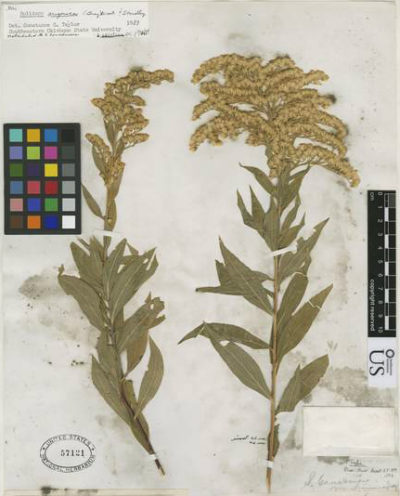Specimens of goldenrod sewn into archival paper folders are stacked floor to ceiling inside metal cabinets at the Smithsonian National Museum of Natural History. The collection, housed in the herbarium, dates back to 1842 and is among five million historical records of plants from around the world cataloged there. Researchers turned to this collection of goldenrod — a widely distributed perennial plant that blooms across North America from summer to late fall — to study concentrations of protein in goldenrod pollen because it is a key late-season food source for bees.
The newer samples look much like the older generations. But scientists testing the pollen content from goldenrod collected between 1842 and 2014, when atmospheric concentrations of carbon dioxide rose from about 280 parts per million to 398 ppm, found the most recent pollen samples contained 30 percent less protein. The greatest drop in protein occurred from 1960 to 2014, when the amount of carbon dioxide in the atmosphere rose dramatically. A field experiment in the same study that exposed goldenrod to CO2 levels ranging from 280 to 500 ppm showed similar protein decreases.
More than 100 previous studies have shown that elevated levels of atmospheric carbon dioxide decrease the nutritional value of plants, such as wheat and rice. But the goldenrod study, published last month, was the first to examine the effects of rising CO2 on the diet of bees, and its conclusions were unsettling: The adverse impact of rising CO2 concentrations on the protein levels in pollen may be playing a role in the global die-off of bee populations by undermining bee nutrition and reproductive success.
“Pollen is becoming junk food for bees,” says Lewis Ziska, a plant physiologist at the U.S. Department of Agriculture’s (USDA) Research Service in Maryland and lead author of the study. The study itself concluded that the decline of plant proteins in the face of soaring carbon dioxide concentrations provides an “urgent and compelling case” for CO2 sensitivity in pollen and other plant components.
Elevated CO2 levels affect plant physiology by enabling the plant’s starchier parts to grow faster and bigger, since atmospheric carbon dioxide is a building block for plant sugars. For goldenrod, this growth essentially dilutes the plant’s total protein, rather than concentrating it in the grain, which makes a starchier pollen.
From 2006 to 2011, losses from managed honeybee colonies averaged 33 percent per year in the U.S.
“I knew there was work done on insects about how rising CO2 would reduce the protein content of leaves, and so insects will need to eat more leaves to get the same amount of protein,” says Ziska. “But until now, we didn’t know about how CO2 affects protein content in pollen.” The study is a synthesis of the knowledge about what is happening to bees and how CO2 impacts the quality of plants, and it brings those two disparate ideas together.
A number of new and accumulating pressures are threatening bee populations. From 2006 to 2011, annual losses from managed honeybee colonies averaged 33 percent per year in the United States, according to the USDA. Beekeepers have had to replace 50 percent of their colonies in recent years. Factors such as mite outbreaks and the use of neonicotinoid pesticides have been implicated in so-called “colony collapse disorder.”
“I am not saying that understanding neonicotinoids or Varroa mites is not important, but I am saying that how bees respond to these stressors might have something to do with their nutrition,” says Ziska. “If we are mucking around with their nutrition, all these other responses could be affected.”
Bees eat two foods to keep them alive, nectar and pollen, which are fundamentally sugar and protein. Bees can scout a good source of nectar and tell the rest of the hive where it can be found. But bees don’t have a communication strategy for protein. They cannot recognize whether the pollen they consume is a good protein source or not. And by late fall, when bees begin to store food for the winter, the pollen choices are limited.
“It’s not like honeybees and native bees have a menu of lots of different species to choose from,” says Joan Edwards, a pollen ecologist at Williams College in Massachusetts and co-author of the goldenrod study. “Because goldenrod and asters are the only food available for bees [in late season], it limits their ability to adapt. They can’t turn to another food source.”
Some beekeepers have turned to supplementing food for honeybee populations, but native bees like bumble bees don’t have that option, explains Edwards. “Native bees do the lion’s share of pollination,” says Edwards. “Bumble bees and solitary bees provide a free ecosystem service for our food supply. Lack of protein is threatening native pollinators, which has huge public health consequences.” Roughly 35 percent of global crop production depends on pollination to produce fruit, vegetables, seeds, nuts, and oils.
Unlike other insects, which will eat more leaves to compensate for lower protein levels in their food, bees will eat a quantity of pollen, but will not adjust consumption based on nutritional inferiority, says entomologist Jeff Pettis, research leader at the USDA’s bee laboratory. However, at least one laboratory study indicates that bees can be resilient to nutritional stress. The laboratory bees foraged for a broader diet, if one is available, to compensate for a nutrition imbalance by identifying complementary types of pollen — similar to how vegetarians balance legumes and grains to get a complete protein.
“Overall the diet of pollinators is going down due to land degradation, pesticide use, and habitat destruction, and now the protein content of their pollen is less,” says Pettis. Scientists know that inferior-quality pollen has an immediate effect of shortening the lifespan of bees because it directly affects the size and strength of the bee colony that will survive until spring. The lack of nutrition may alter bee behavior and vigor and contribute to colony collapse and degraded health of pollinators.
May Berenbaum, professor of entomology at the University of Illinois, says that bees are having a hard time getting enough protein as it is. “A declining quality of protein across the board almost assuredly is affecting bees,” she says. “Like humans, good nutrition is essential for bee health by allowing them to fend off all kinds of health threats. Anything that indicates that the quality of their food is declining is worrisome.”
By itself, the relative effect of lower nutrition might be small, but it still might be important, says David Hawthorne, associate professor of entomology at the University of Maryland. “It’s like death by a thousand blows,” Hawthorne says. “With all of these other stresses on bees, it could still matter because it may just be the straw that breaks the beehives’ back.”
The findings that the nutritional quality of plants is changing and affecting pollinators fits squarely with a new field of interdisciplinary research called Planetary Health, which has emerged to assess the links between a changing planet and plant and human health.
Samuel Myers, a senior research scientist at Harvard’s School of Public Health, has published groundbreaking studies on how rising CO2 levels lower the nutritional quality of foods that we eat, like rice, wheat, and maize, which lose significant amounts of zinc, iron, and protein when grown under higher concentrations of CO2. Plant composition depends on a balance between air, soil, and water. As CO2, the source of carbon for plant growth, proliferates quickly in the atmosphere, soil nutrients — such as nitrogen, iron, and magnesium — remain the same. As a result, plants produce more carbohydrates, but dilute other nutrients.
The loss of pollinators would place 71 million people into vitamin A deficiency and 173 million into folate deficiency.
In one study, Myers estimated that lower nutritional values in crops will push an estimated 132 million to 180 million people into a new risk of zinc deficiency. “Low levels of micronutrients are already an enormous health burden today and where people get iron and zinc is primarily from these kinds of crops,” says Myers. “With rising CO2, they get significant further reductions. That is a big deal from the global nutritional standpoint.”
Myers — director of the Planetary Health Alliance, a new trans-disciplinary consortium aimed at understanding and addressing human health implications of Earth’s changing natural systems — also modeled how the complete decline in pollinators would affect human health. He calculated that the loss of pollinators would place 71 million people into vitamin A deficiency (which is linked to child mortality) and 173 million into folate deficiency (which is associated with birth defects). An additional 2.2 billion people already lacking in vitamin A would suffer more severe deficiencies, he projected. Overall, there would be 1.4 million excess deaths annually from complete pollinator decline.
Now, new research questions are emerging to connect Myers’ research with Ziska’s with the goal of improving understanding of where this reduced pollen protein content is occurring globally and whether it is altering the nutritional status and health of bee populations. “One could imagine there are new nutritional impacts yet to be discovered,” Myers says. “If it is happening in goldenrod, there is no reason to believe this is not happening in other plants.”
Myers said that a core principle in the field of planetary health is the element of surprise, which Ziska’s study illustrates. “We are fundamentally transforming all of the biophysical conditions that underpin the global food system,” said Myers. “Global food demand is rising at the same time the biophysical conditions are changing more rapidly than ever before. Chances are there are more surprises coming down the road. This is the tip of the iceberg in our understanding of changing health in a system that is changing rapidly.”
Beyond the pollen–bee nexus, the extent and rate of multiple interacting environmental changes — including global warming, biodiversity loss, freshwater depletion, ocean acidification, and land use change — are unprecedented in human history. “The research showing how loss of pollinators could have serious adverse effects on nutrition and health outcomes is an important example of how environmental change can undermine human health,” Sir Andy Haines, a professor at the London School of Hygiene and Tropical Medicine, said in an email.
Researcher Lewis Ziska thinks plants will adapt and change to rising atmospheric carbon dioxide. But gesturing to the stacks of specimens at the herbarium at the Museum of Natural History, he says, “Here are 450,000 plant species, and every other living organism depends on plants as a food source. The fact that they are changing, all at different rates in an unprecedented time — it is pretty remarkable in trying to assess how the entire food web is changing.”




